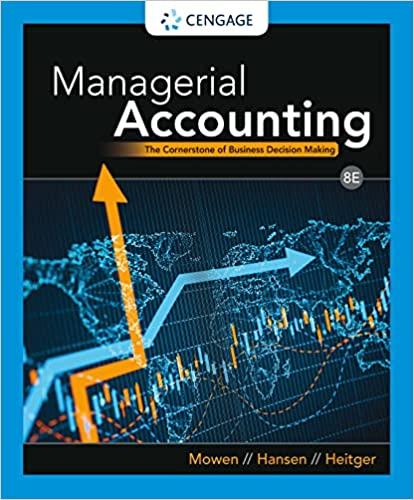Question
Q1) which of the following is true with respect to the allocation of costs? a)The step down method assigns costs from service departments and between
Q1) which of the following is true with respect to the allocation of costs? a)The step down method assigns costs from service departments and between service departments in step-down fashion. b)The step down method assigns costs from service departments and between operating departments in a step down fashion. c)The direct method assigns costs from operating departments to service departments. d)The direct method assigns costs from operating departments to service departments and other operating departments.
Q2) which of the following is false with respect to contribution margin? a)The total contribution margin will increase when fixed expenses decrease. b) if you multiply the contribution margin ratio by the selling price per unit, you will obtain the contribution margin per unit. c) The contribution margin ratio will not change with a change in the quantity of sales. d) the contribution margin per unit is calculated as the difference between the sales price per unit and the variable cost per unit.
Q3) If sales price per unit increases and everything else remains the same, which of the following is true? a) the break-even point will decrease. b) the break-even point will increase. c) the margin of safety will decrease. d) the contribution margin per unit will decrease.
Q4) which of the following incorrectly categorizes what is included as a product and period costs under variable and absorption costing. a) variable costing treats direct labour a a product cost. b) variable costing treats sales commissions as a product cost. c) absorption costing treats sales commissions as a period cost. d) absorption costing treats variable manufacturing overhead as a product cost.
Q5)which of the following is false? assume a company has direct material, direct labour, variable manufacturing overhead, fixed manufacturing overhead costs. a) if a company produces more than it sells in year 1, net operating income will be higher under absorption costing compared to variable costing in year 1. b) if a company produces less than it sells in year 2 instead of selling some inventory from year 1, net operating income will be higher under variable costing compared to absorption costing in year 2. c) if a company produces the sae as it sells in year 1, net operating income will be higher under absorption costing compared to variable costing year 1. d) if a company builds up inventory, absorption costing net operating income will be greater than variable costing net operating income
Step by Step Solution
There are 3 Steps involved in it
Step: 1

Get Instant Access to Expert-Tailored Solutions
See step-by-step solutions with expert insights and AI powered tools for academic success
Step: 2

Step: 3

Ace Your Homework with AI
Get the answers you need in no time with our AI-driven, step-by-step assistance
Get Started


